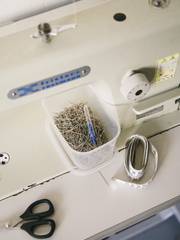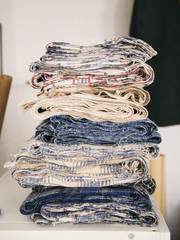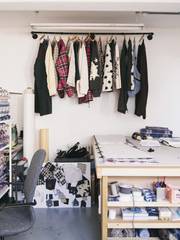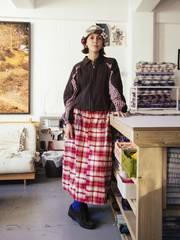Made in London by designer Esme Marsh, This Uniform creates functional and modular garments and accessories that focus on an ethical production without compromising on design. Sourcing vintage fabrics locally and saving off-cuts for future designs, Esme produces one-of-a-kind investment pieces, made in limited runs, that champion quality and durability. We caught up with Esme in her London studio to find out more about the person and the values behind the brand. Check it out below...


GOODHOOD: To those who don’t know, who are you and what do you do?
Esme Marsh: My name is Esme Marsh and I run a slow fashion brand called This Uniform. I started This Uniform (TU) two years ago focusing on durability and functionality with the aim to make clothes that last without compromising on the design.
GH: Where did your name, This Uniform, come from?
EM: The name ‘This Uniform’ is a reference to the everyday uniform I aim to create. When I started This Uniform I wanted to create comfortable clothes which are not trend-led or influenced by the seasons. With this, is this idea of being a modular brand, meaning every garment can be worn with every other TU garment. This is the uniform I want to wear every day; I thought other people might want to as well.
GH: Where did your desire to create This Uniform come from?
EM: Having worked briefly in the fashion industry before starting TU, I saw a lot of things that made me deeply uncomfortable. Everyone knows the fashion industry is a far cry from perfect when it comes to being sustainable, so I created This Uniform with the aim of building a brand with sustainability at the forefront whilst still feeling relevant and original. I want to use the potential limitations that being a slow-fashion brand imposes to develop new ways of designing; it forces us to think unconventionally, from how and where you source your fabrics, to the number of seams you design into a garment.
"IT FORCES US TO THINK UNCONVENTIONALLY, FROM HOW AND WHERE YOU SOURCE YOUR FABRICS, TO THE NUMBER OF SEAMS YOU DESIGN INTO A GARMENT"



GH: Can you go into some detail about your collection? From the fabric, to initial designs, to final pieces?
EM: This collection has a very tactile feel to it which is symbolic of slowing down how we approach clothes. Sourcing the fabric has been a vital part of the process and each chosen fabric has been carefully considered; from heavy weight organic cotton denim to deadstock British tweed and vintage cotton from the 1950s. All the patchwork hats are made from offcuts from the collection to minimise waste. We have a special box in the studio where we keep every off-cut that is larger than 10cm x 10cm, anything smaller is recycled. The small details such as seersucker binding are very important for this collection. Everything is made in London to the highest quality and sewn to last a very long time. As for the silhouettes, they are mostly motivated by photos of my friends. Sometimes there is a pressure to design big, over-the-top garments but that defeats the point of This Uniform. My friends are my biggest inspiration and I want to design a uniform for them where the beauty lies in the intricate details.
GH: And if you had to choose a favourite piece?
EM: The Vintage Cotton Skirts. They are so versatile and level up every outfit. They are made from the vintage cotton which is a big part of This Uniform’s identity. I source the cotton from an antiques dealer and every time I get a new delivery it’s a very happy day in the studio.
GH: How do your source your fabrics?
EM: As I mentioned, the fabric sourcing process is a very integral part of TU. I spend a lot of time narrowing down the fabrics that will be used for each garment and have to ensure that no first-time plastic (e.g. polyester) is blended into the mix. I collect so many fabric samples from various places and spend full days narrowing them down on huge boards next to drawings of the designs and samples of different design features such as seams.
"SOMETIMES THERE IS A PRESSURE TO DESIGN BIG, OVER-THE-TOP GARMENTS BUT THAT DEFEATS THE POINT OF THIS UNIFORM"


GH: What do you listen to whilst working?
EM: It depends on what I am doing really. I often work late nights in the studio, and when everyone has gone to home to rest, I have recently been (very loudly) playing lots of alternative-pop like Caroline Polachek, Saya Gray and Dora Jar to keep the energy up. Dijon is played most days too… but I also secretly watch (a lot of) trash TV shows when I am sewing. It can’t be anything I have to focus on or physically watch the screen for, but I find it very therapeutic and weirdly the background noise keeps me focused. Somehow I managed to have my most productive sewing stint in a long time whilst watching the entire new series of Top Boy in one sitting.
GH: What are your key sources of inspiration?
EM: My friends really are my biggest inspiration. I’ve learnt so many cool things from all of them and I really do design clothes with them in mind always. I also love this idea that clothes tell stories when they have lived many lives and passed through multiple people. I am building an archive of second hand clothes which have interesting features or have been worn down or repaired in certain ways and I always reference these when designing.
GH: Dream collaborator?
EM: It would have to be collaborating with Nike on a trainer. Being a London based brand it would be cool to collaborate on a pair of Air Max 90s. I think This Uniform could bring some interesting fabric combinations and textures to the board. I run a lot too, so a more sporty shoe like a pair of Zoom Vomero 5s could be very fascinating to develop, balancing the technical needs with a more natural element.
GH: What does a day in the (working) life look like?
EM: This is a hard question to answer as every day looks so different. Someone comes in once a week to work with me and I source most of the production out-of-house, but other than that I am still a one person brand. This means I do everything from the pattern cutting, designing, technical packs for production, fabric sourcing, toiling etc. One thing that stays consistent is that I make sure that most lunch times I stop, eat a lot of good food and then talk a walk with no headphones in Southwark park. I find it so restorative to go outside, reset, and listen to the world around me.



GH: What does ‘slow fashion’ mean to you?
EM: ‘Slow fashion’ is quite literally the opposite of ‘fast fashion’. For me it is about really slowing everything down and making considered and deliberate choices; It’s being close to the entire process from the beginning to end and making sure nothing goes unnoticed; It’s remaining transparent; it’s avoiding trend-led designs and focusing on well-made clothes that remain relevant; It’s about being kind to everyone involved.
GH: How do you think we, as two businesses with similar values around slow fashion and environmentally friendly practices, help to shift the consumer away from fast-fashion?
EM: I think it is a very exciting time to be in this industry, consumer culture is really starting to shift. I want to continue working with people exploring new ways to bring sustainability into design in a new way that is exciting. One thing I am very passionate about it clothing repair; avoiding overconsumption is principle for TU, which is why we have always only made small batches or made-to-order. Going forward I aim to lead workshops based around visible mending and repair techniques as I think it can become a beautiful development of the design rather than a flaw in the item. ‘Slow fashion’ can seem intimidating or unobtainable to a lot of people; a lot of new words flying about, often higher prices and slower delivery times. Sharing knowledge and coming together like this makes slow fashion accessible to more people. I love learning from other people too, and when we invite everyone along to share and grow collectively I think there will be a real consumer shift away from fast fashion.
GH: What are the biggest obstacles you’ve faced, as the director of a slow fashion business?
EM: I would say the biggest obstacle I face currently is trying to navigate making the brand financially accessible, as I touched on above. A sustainable brand is great, but when the prices are high it becomes less attainable for a lot of people. Of course, a higher price isn’t necessarily prohibitive if the clothing has durability at its core (the concept of ‘pay more, buy less’, which also has the added benefit of minimising over-consumption), and this is at the centre of the This Uniform brand, but I am constantly trying to consider accessibility more broadly at every opportunity. Additionally, when you only make small batches or made-to-order then the production price per unit is much more expensive than getting a much larger batch made, so this is something I am trying to navigate.
"I THINK IT IS A VERY EXCITING TIME TO BE IN THE INDUSTRY, CONSUMER CULTURE IS REALLY STARTING TO SHIFT"

GH: What is your ultimate goal for This Uniform?
EM: Whilst This Uniform is a fashion brand, it is just as importantly an open space where I, and hopefully others, can try to constructively confront some of the shortcomings within the industry. It’s about changing how we approach the industry rather than fighting shy of it altogether. The more we share our knowledge, experiment and get things wrong, the closer we get to slowly reconstructing the industry and giving it new life. This is the ultimate goal.
GH: Anything exciting in the works you can share with us?
EM: I am currently working on the new collection which involves new silhouettes to add to our uniform. Some jersey items coming which I haven’t released before and lots of new bags for every occasion.

